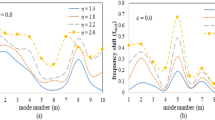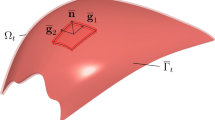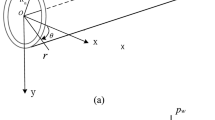Applying the second variant of the boundary-shape perturbation method and using three-dimensional equations and relations of the elasticity theory including the first three approximations the author has obtained an analytical solution to the problem of elastic equilibrium for noncanonical near-cylindrical shells subjected to fluctuating axial external forces. The influence of individual shapes of noncanonical shells, amplitude and parameter of oscillation of boundary surfaces in the axial or circumferential directions on the value of maximum stresses has been clarified. An almost numerical convergence is demonstrated, based on contribution (in absolute magnitude) of each of the approximations to the sum total. For a shell in the form of bellows, which is under a permanent external pressure, a comparison is made between the hoop stress values as found by the boundary-shape perturbation method and the data obtained by the finite-difference method using equations of the Vekua theory of shells.



Similar content being viewed by others
References
V. G. Petushkov, The Use of Explosion in Welding Engineering [in Russian], Naukova Dumka, Kiev (2005).
V. I. Gulyaev, V. A. Bazhenov, and P. P. Lizunov, The Nonclassical Theory of Shells and Its Application to the Solution of Engineering Problems [in Russian], Vyshcha Shkola, Lvov (1978).
Ya. M. Grigorenko and L. I. Zakhariichenko, “Studying the effect of the spatial frequency and aplitude of corrugation on the stress-strain state of cylindrical shells,” Prikl. Mekh., 39, No. 12, 78–85 (2003).
N. P. Semenyuk and N. A. Neskhodovskaya, “Timoshenko-type theory in the stability analysis of corrugated cylindrical shells,” Prikl. Mekh., 38, No. 6, 99–107 (2002).
G. I. Brankov, “Some special features of the investigation of undulating shells,” in: Continuum Mechanics and Related Problems of Analysis [in Russian], Nauka, Moscow (1972), pp. 79–88.
Ya. M. Grigorenko and N. D. Pankratova, Computational Methods in Applied Mathematical Problems [in Ukrainian], Lybid’, Kiev (1995).
Ya. M. Grigorenko and L. S. Rozhok, “On one approach to the solution of stress problems for noncircular hollow cylinders,” Prikl. Mekh., 38, No. 5, 61–71 (2002).
A. N. Guz’ and Yu. N. Nemish, Boundary-Shape Perturbation Method in Continuum Mechanics [in Russian], Vyshcha Shkola, Kiev (1989).
Yu. M. Nemish, “Elastic equilibrium of deformable cylinders of variable thickness,” DAN URSR, Ser. A, No. 2, 155–158 (1973).
C. K. Youngdohl, “On the completeness of a set of stress elasticity problems in general cylindrical coordinates,” Int. J. End. Sci., 7, No. 1, 61–79 (1969).
D. I. Chernopiskii, “Some characteristics of the design of deformable cylinders in modified Bessel functions,” Prikl. Mekh., 14, No. 6, 45–51 (1978).
Author information
Authors and Affiliations
Additional information
Translated from Problemy Prochnosti, No. 1, pp. 58 – 74, January – February, 2012.
Rights and permissions
About this article
Cite this article
Chernopiskii, D.I. On stress-strain state in thick-walled cylindrical shells bounded by corrugated surfaces. Strength Mater 44, 40–52 (2012). https://doi.org/10.1007/s11223-012-9347-8
Received:
Published:
Issue Date:
DOI: https://doi.org/10.1007/s11223-012-9347-8




